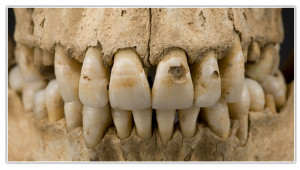Archeology Uncovers oral bacteria and gum disease in the past
STD’s, Oral Sex and The Mouth – Part 1by Dr. Ari Greenspan
March 21, 2013STD’s, Oral Sex and The Mouth- Dr. Ari Greenspan Part 2
April 14, 2013
Gum Disease
An oral history
Teeth bacteria are the latest organisms to be studied through “ancient DNA” technology, which allows scientists to extract and amplify tiny traces of genetic material from specimens thousands of years old. The conclusions are bad news for modern oral health.
An international team led by Alan Cooper of the University of Adelaide extracted DNA from tartar (calcified dental plaque) from 34 north European skeletons, spread over 7,500 years, from the last hunter-gatherers, through the first farmers, to Bronze Age, medieval and modern times.
“Oral bacteria in modern man are markedly less diverse than historic populations, and this is thought to contribute to chronic gum disease, oral and other disease in post-industrial lifestyles,” says Cooper, in the journal Nature Genetics.
“The composition of oral bacteria changed markedly with the introduction of farming and again around 150 years ago,” he adds. “With the introduction of processed sugar and flour in the Industrial Revolution, we can see a dramatically decreased diversity in our oral bacteria, allowing domination by caries-causing strains and gum disease. The modern mouth basically exists in a permanent disease state.”
From the Financial Times April 5 ,2013